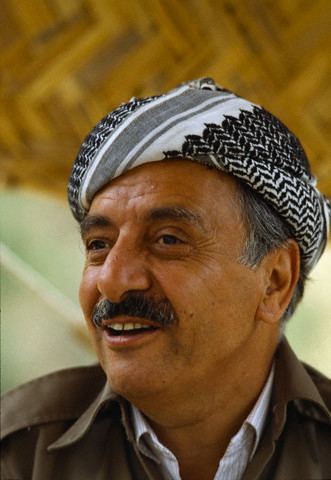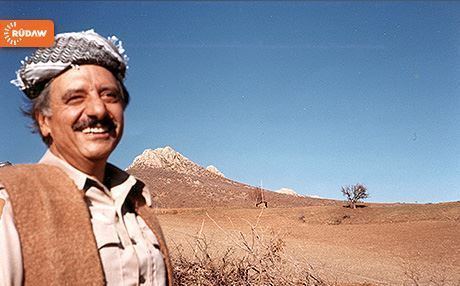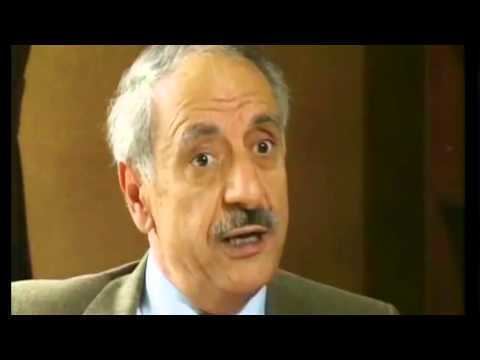Native name عەبدولڕەحمان قاسملوو Role Political leader Name Abdul Ghassemlou | Nationality Iranian Kurd Spouse Helen Krulich (m. ?–1989) | |
 | ||
Cause of death Assassinated, possibly by the Iranian Ministry of Intelligence and National Security Other names The prophet of Peaceپێغەمبەری ئاشتی Children Mina Ghassemlou, Hiwa Ghassemlou Similar People Abolhassan Banisadr, Massoud Rajavi, Ruhollah Khomeini, Ashraf Dehghani, Ali Sayad Shirazi | ||
Resting place Pere Lachaise Cemetery | ||
pdki the life death of dr a r ghassemlou dr abdul rahman ghassemlou immortal dr ghasemlou
Abdul Rahman Ghassemlou (Kurdish: عەبدولڕەحمان قاسملوو, Ebdulrehman Qasimlo) (22 December 1930 – 13 July 1989) was a Kurdish political leader. Ghassemlou was the leader of the Kurdistan Democratic Party of Iran (KDPI) (حیزبی دێموکراتی کوردستانی ئێران - PDKI) from 1973 until his assassination in 1989 by individuals suspected of being agents of the Islamic Republic of Iran. As the secretary general of the Kurdistan Democratic Party of Iran (KDPI) he led the Kurdish nationalist struggle for Kurdish autonomy in Iran.
Contents
- pdki the life death of dr a r ghassemlou dr abdul rahman ghassemlou immortal dr ghasemlou
- Abdul rahman ghassemlou
- Early life and education
- Career
- Books
- Assassination and funerals
- Investigation
- References

Abdul rahman ghassemlou
Early life and education

Born in Urmia, West Azerbaijan, Iran to a wealthy feudal family, Abdul Rahman Ghassemlou was instructed in a Quranic school. His father was Mohammad Vesugh Ghassemlou, a landowning Kurdish nationalist Agha and Khan from the Shekak tribe who was born in 1875. His mother was Nana Jan Timsar, also known as Fatima, was an Assyrian Christian, who converted to Islam. His father was an adviser to the Shah of Iran, who gave him the title "Wussuq-e Divan." He completed his early education in Urmia and then on Tehran. He witnessed the Republic of Mahabad and became a co-founder member of the youth wing of KDP-I at the age of 15. Ghassemlou moved to France to continue his studies at Sorbonne. He meet his wife Helen Krulich in Czechoslovakia. They had two daughters together, Mina (1953) and Hewa (1955).

Abd-al-Raḥmān Qāsemlu was fluent in 8 languages Kurdish, Persian, Arabic, Azerbaijani, French, English, Czech, Russian. He was also familiar with German.
Career

Ghassemlou went back to Kurdistan in 1952 after completing his studies. He then spent several years as an active militant in the Kurdish military fields. In 1973, during the Third Congress of the PDKI, he was elected to the position of secretary general of the party, a position to which he was reelected several times until his assassination.

In 1979, his party supported the revolution which ended in the fall of Mohammad Reza Shah Pahlavi. Khomeini considered their last hour participation in the revolution as opportunistic. Militants belonging to the party had overtaken the military compounds in the Kurdish areas. Khomeini demanded all armed groups to become part of one revolutionary organization and demanded Kurdish militants to return their weapons. Ghasemlou demanded autonomy for Kurds and refused to lay down weapons. The party boycotted the referendum for the new constitution which was adopted by overwhelming majority. Following two bloody confrontation between Kurds and forces loyal to Khomeini the Kurdish rebellion turned into a war. Shortly, after the beginning of the armed Kurdish rebellion, Ayatollah Khomeini declared a "holy war" on the PDKI and Kurdish rebels. This was the start of confrontation of the party and the new regime, which ended in a military defeat of the Kurdish rebels and political suppression of the Kurdish nationalist parties by the central government. Thousands of executions happened in Kurdistan during the rebellion. The armed conflict continued up to 1984 in the middle of Iran-Iraq war (1980–1988) where both countries supported the separatists in each other's territory.
After the defeat of the armed rebellion Ghassemlou settled in Paris and joined the National Council of Resistance of Iran that was founded by his PDKI and other opposition forces: the Islamist-Marxist People's Mujahedin, the liberal-leftist National Democratic Front, the United Left of small socialist groupings, and the independent Islamist-leftist Abolhassan Bani Sadr, in October 1981.
Books
"Kurdistan and Kurd" is a book on the history of Kurds and their land written by Ghassemlou and published in 1964 in Slovaki, 1965 in English, 1967 in Arabic, 1969 in Polish, and 1973 in Kurdish.
Assassination and funerals
In 1988, after the war had ended, the Iranian government decided to meet with him. Several meetings followed in Vienna, on 28 December, 30 December and 20 January 1989. Another meeting was set up for 13 July, again in Vienna.
The Tehran delegation was as before, namely Mohammed Jafar Sahraroudi and Hadji Moustafawi, except that this time there was also a third member: Amir Mansur Bozorgian who was a bodyguard. The Kurds also had a three-man delegation: Abdul Rahman Ghassemlou, his aide Abdullah Ghaderi Azar (a member of the PDKI Central Committee) and Fadhil Rassoul, an Iraqi university professor who had acted as a mediator.
The next day, 13 July 1989, in the very room where the negotiation took place, Ghassemlou was killed by three bullets fired at very close range. His assistant Ghaderi Azar was hit by eleven bullets and Rassoul by five. Hadji Moustafawi succeeded in escaping. Mohammad Jafar Sahraroudi received minor injuries and was taken to hospital, questioned and allowed to go. Amir Mansur Bozorgian was released after 24 hours in police custody and took refuge in the Iranian Embassy.
His deputy, Sadegh Sharafkandi, succeeded Ghassemlou as secretary general until his assassination on 17 September 1992 in Mykonos restaurant in Berlin, Germany. Abdullah Ghaderi Azar and Abdul Rahman Ghassemlou were buried on July 20 in Paris at Père Lachaise Cemetery.
Investigation
According to PDKI
In late November 1989 the Austrian courts issued a warrant for the arrest of the three Iranian representatives and the Austrian Government expressly accused the Iranian Government as having instigated the attack on Abdul Rahman Ghassemlou and the two other Kurds.
The three Iranian representatives in the negotiations with the Kurdish leaders returned to Iran freely. One of them had never been in custody, one was escorted by Austrian police to the Vienna airport nine days after the assassination, and the third, after one night of arrest, spent a few months in the Iranian embassy in Vienna before he disappeared from Austria. One of the suspects was Mohamed Magaby, whom the Kurdish protesters in Vienna requested to be arrested and be put under travel ban. Warrants for their arrest were not issued until November 1989. The warrants have never been executed. Unlike the German Mykonos trial for the assassination of Ghassemlou's successor Sadegh Sharafkandi in Berlin, the assassination in Vienna was never clarified by any court. The Mykonos verdict of 1 April 1997 put the responsibility on the Iranian government of the time for the murders in Berlin and in Vienna.
